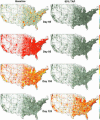Mitigation strategies for pandemic influenza in the United States
- PMID: 16585506
- PMCID: PMC1458676
- DOI: 10.1073/pnas.0601266103
Mitigation strategies for pandemic influenza in the United States
Abstract
Recent human deaths due to infection by highly pathogenic (H5N1) avian influenza A virus have raised the specter of a devastating pandemic like that of 1917-1918, should this avian virus evolve to become readily transmissible among humans. We introduce and use a large-scale stochastic simulation model to investigate the spread of a pandemic strain of influenza virus through the U.S. population of 281 million individuals for R(0) (the basic reproductive number) from 1.6 to 2.4. We model the impact that a variety of levels and combinations of influenza antiviral agents, vaccines, and modified social mobility (including school closure and travel restrictions) have on the timing and magnitude of this spread. Our simulations demonstrate that, in a highly mobile population, restricting travel after an outbreak is detected is likely to delay slightly the time course of the outbreak without impacting the eventual number ill. For R(0) < 1.9, our model suggests that the rapid production and distribution of vaccines, even if poorly matched to circulating strains, could significantly slow disease spread and limit the number ill to <10% of the population, particularly if children are preferentially vaccinated. Alternatively, the aggressive deployment of several million courses of influenza antiviral agents in a targeted prophylaxis strategy may contain a nascent outbreak with low R(0), provided adequate contact tracing and distribution capacities exist. For higher R(0), we predict that multiple strategies in combination (involving both social and medical interventions) will be required to achieve similar limits on illness rates.
Conflict of interest statement
Conflict of interest statement: No conflicts declared.
Figures


References
-
- Stöhr K., Esveld M. Science. 2004;306:2195–2196. - PubMed
-
- Tumpey T. M., Basler C. F., Aguilar P. V., Zeng H., Solórzano A., Swayne D. E., Cox N. J., Katz J. M., Taubenberger J. K., Palese P., et al. Science. 2005;310:77–80. - PubMed
-
- Longini I. M., Nizam A., Xu S., Ungchusak K., Hanshaoworakul W., Cummings D. A. T., Halloran M. E. Science. 2005;309:1083–1087. - PubMed
-
- Ferguson N. M., Cummings D. A. T., Cauchemez S., Fraser C., Riley S., Meeyai A., Iamsirithaworn S., Burke D. S. Nature. 2005;437:209–214. - PubMed
-
- Kermack W. O., McKendrick A. G. Proc. R. Soc. London Ser. A; 1927. pp. 700–721.
Publication types
MeSH terms
Substances
Grants and funding
LinkOut - more resources
Full Text Sources
Other Literature Sources
Medical

